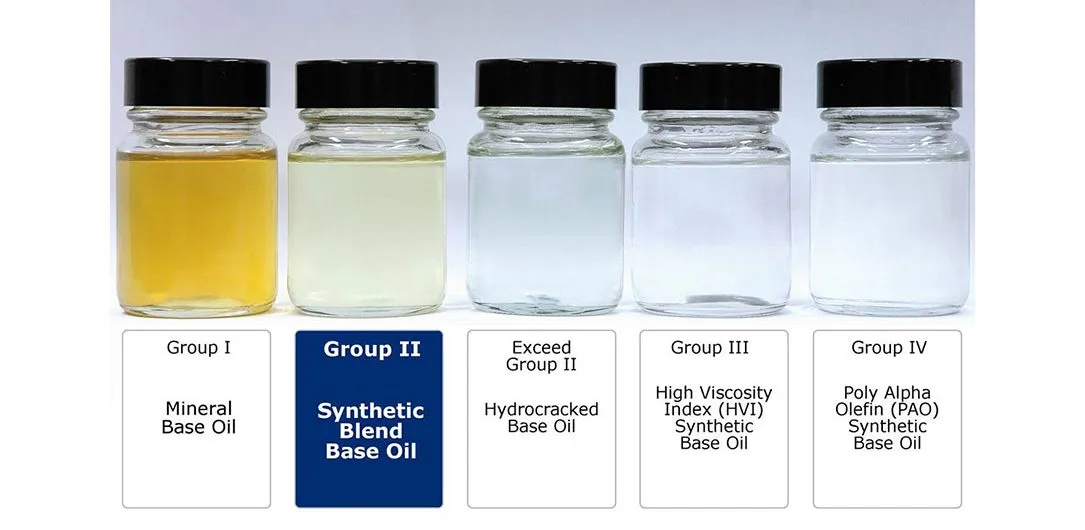


In the automotive industry, lubricants play a vital role in ensuring smooth operation and prolonged lifespan of various components. At the heart of these lubricants lies a crucial ingredient known as base oil. This article delves into the intricacies of base oils, exploring their types, production processes, properties, applications, and future trends, providing a comprehensive understanding of these essential lubricant foundations.

Base oils are the primary components of lubricants, accounting for a significant portion of their composition, typically ranging from 70% to 95%. They serve as the foundation upon which various lubricant formulations are built, including engine oils, gear oils, hydraulic fluids, and greases. The performance and characteristics of the finished lubricant product are heavily influenced by the base oil's properties, making it a critical factor in determining the overall effectiveness of the lubricant.
This comprehensive guide will explore the different types of base oils, their production methods, key properties, and applications across various industries, with a particular focus on the automotive sector. Additionally, we will delve into the future trends and sustainable practices shaping the base oil industry, highlighting the importance of environmental considerations and the pursuit of higher quality and improved performance.
Base oils can be broadly classified into two main categories: mineral base oils and synthetic base oils. Each category offers distinct characteristics and properties, catering to specific application requirements.
Mineral base oils are derived from crude oil through refining processes. The American Petroleum Institute (API) has categorized mineral base oils into three groups based on their refining processes and properties:
| Group | Refining Process | Viscosity Index (VI) Range | Saturates Content | Sulfur Content |
|---|---|---|---|---|
| I | Solvent Refining | 80-120 | < 90% | > 0.03% |
| II | Hydrocracking | 80-120 | ≥ 90% | ≤ 0.03% |
| III | Severe Hydrocracking and Hydroisomerization | ≥ 120 | ≥ 90% | ≤ 0.03% |
Group I Base Oils: These are the least refined base oils, produced through solvent refining. They have a lower viscosity index (VI) range of 80-120, indicating a significant change in viscosity with temperature variations. Group I base oils typically contain less than 90% saturates and more than 0.03% sulfur.
Group II Base Oils: Produced through a more advanced hydrocracking process, Group II base oils have a higher level of refinement. They contain greater than or equal to 90% saturates and less than or equal to 0.03% sulfur, with a VI range of 80-120.
Group III Base Oils: These are the most refined mineral base oils, obtained through severe hydrocracking and hydroisomerization processes. Group III base oils have a VI greater than or equal to 120, indicating excellent viscosity stability across a wide temperature range. They contain greater than or equal to 90% saturates and less than or equal to 0.03% sulfur.
Synthetic base oils are chemically synthesized rather than derived from crude oil. The API has classified synthetic base oils into two groups:
Group IV Base Oils: These are polyalphaolefins (PAOs), which are synthesized through the polymerization of alpha-olefin monomers. PAOs have a high VI, typically ranging from 125 to 200, and are known for their exceptional performance in extreme temperature conditions.
Group V Base Oils: This group includes all other synthetic base oils not covered in Groups I-IV, such as polyalkylene glycols (PAGs), esters, and silicone-based fluids. These base oils are often used in specialized applications or blended with other base stocks to enhance specific properties.
The production of base oils involves several refining processes applied to crude oil. The primary steps include:

Atmospheric Distillation
Crude oil is heated, and the lighter fractions (gasoline, kerosene, etc.) are separated from the heavier fractions containing base oil components.
Vacuum Distillation
The heavier fractions from atmospheric distillation undergo further distillation under vacuum conditions to separate the base oil fractions from residual components.
Refining Processes
Depending on the desired base oil group, various refining processes are employed, such as:
Solvent Extraction
Hydrocracking
Severe Hydrotreatment
These processes remove impurities, unwanted components, and improve the properties of the base oil.
Dewaxing
This step removes wax components from the base oil to improve its low-temperature performance.
Finishing Processes
Additional treatments, such as clay treatment or hydrofinishing, may be applied to enhance the color, stability, and other properties of the base oil.
Base oils are characterized by several key properties that determine their suitability for different applications. These properties include:
Viscosity Index (VI)
The VI measures the change in viscosity with temperature variations.
A higher VI indicates better viscosity stability across a wide temperature range, which is crucial for automotive applications where engines operate under varying temperature conditions.
Oxidation Stability
This property reflects the resistance of the base oil to oxidation, which can lead to sludge formation and degradation.
Excellent oxidation stability is essential for prolonging the lifespan of automotive lubricants and preventing premature breakdown.
Volatility
Low volatility is desirable to minimize evaporative losses and maintain the lubricant's viscosity.
In automotive applications, low volatility helps ensure consistent lubrication performance and reduces the need for frequent top-ups.
Pour Point
The pour point is the lowest temperature at which the base oil remains fluid, ensuring proper flow and pumpability in cold conditions.
This property is particularly important for vehicles operating in extreme cold climates, where low pour points are necessary for reliable engine start-up and lubrication.
Base oils must meet various specifications and standards set by organizations like the API, ACEA (European Automobile Manufacturers Association), and others, depending on their intended applications in the automotive industry.
Base oils find applications in a wide range of industries and products, including:
Automotive Lubricants
Engine oils
Transmission fluids
Gear oils
Greases
These are essential for the smooth operation and protection of various automotive components, such as engines, transmissions, and differentials.
Industrial Lubricants
Hydraulic fluids
Compressor oils
Turbine oils
Metalworking fluids
Used in various industrial applications to lubricate and protect machinery.
Marine Lubricants
Cylinder oils
Trunk piston engine oils
System oils
Used in marine applications to lubricate and protect ship engines and equipment.
Greases
Base oils are used in the production of various greases for lubrication and sealing applications in automotive and industrial settings.
Process Oils
Base oils are used in various industrial processes, such as rubber and plastic manufacturing.
The selection of the appropriate base oil depends on the specific performance requirements, operating conditions, and industry standards for each application in the automotive and related sectors.
As technology advances and environmental regulations become more stringent, the demand for higher-quality base oils continues to grow. There is an increasing shift towards the use of synthetic base oils, particularly Group III and Group IV base oils, due to their superior performance and extended service life.
In the automotive industry, the pursuit of improved fuel efficiency and reduced emissions has led to the development of advanced engine technologies, such as turbocharging and downsizing. These advancements place higher demands on lubricants, necessitating the use of base oils with exceptional oxidation stability, low volatility, and excellent viscosity control.
Additionally, the base oil industry is exploring more sustainable and environmentally friendly production processes, such as the use of renewable feedstocks and the development of bio-based lubricants. These efforts aim to reduce the industry's reliance on crude oil and mitigate its environmental impact, aligning with the growing emphasis on sustainability in the automotive sector.
Some key future trends and developments in the base oil industry include:
Increased adoption of Group III and Group IV synthetic base oils for their superior performance and extended service life.
Development of base oils specifically designed for advanced engine technologies, such as turbochargers and downsized engines.
Exploration of renewable feedstocks, such as biomass or waste materials, for the production of bio-based lubricants.
Implementation of more sustainable and environmentally friendly production processes to reduce the industry's carbon footprint and environmental impact.
Continued research and development to improve base oil properties, such as oxidation stability, viscosity control, and low-temperature performance.
Collaboration between base oil manufacturers, lubricant formulators, and automotive manufacturers to develop tailored lubricant solutions for specific vehicle applications.
Base oils are the foundation of lubricant formulations, playing a crucial role in determining the performance and characteristics of the finished product. With a wide range of base oil types available, from mineral to synthetic, manufacturers can tailor lubricant formulations to meet the specific requirements of various applications in the automotive industry and beyond. As technology advances, the base oil industry continues to evolve, focusing on higher quality, improved performance, and sustainable production practices to meet the ever-increasing demands of modern vehicles and environmental regulations.
The main types of base oils are mineral base oils (Groups I-III) derived from crude oil, and synthetic base oils (Groups IV-V) which are chemically synthesized.
Mineral base oils are classified into Groups I, II, and III by the American Petroleum Institute (API) based on their refining processes, saturates content, sulfur content, and viscosity index.
Group I base oils are the least refined with lower viscosity index, while Group III base oils are the most refined mineral base oils with higher viscosity index and better performance.
Synthetic base oils like polyalphaolefins (PAOs) offer superior performance in extreme temperatures, better oxidation stability, and higher viscosity index compared to mineral base oils.
Base oils are produced through various refining processes applied to crude oil, including atmospheric distillation, vacuum distillation, hydrocracking, dewaxing, and finishing treatments.
Important properties of base oils include viscosity index, oxidation stability, volatility, and pour point, which determine their suitability for different applications.
Base oils are primarily used in automotive lubricants (engine oils, transmission fluids, greases), industrial lubricants, marine lubricants, and as process oils in various industries.
Base oils for automotive applications are selected based on their viscosity, viscosity index, oxidation stability, and ability to meet specific performance requirements and industry standards.
Emerging applications include lubricants for electric vehicles, medical devices, and other specialized applications that require improved thermal stability, biocompatibility, and environmental performance.
Future trends include increased adoption of Group III and Group IV synthetic base oils, development of base oils for advanced engine technologies, exploration of renewable feedstocks, and implementation of more sustainable production processes.

Sarah isn't your average gearhead. With a double major in Mechanical Engineering and Automotive Technology, she dived straight into the world of car repair. After 15 years of turning wrenches at dealerships and independent shops, Sarah joined MICDOT to share her expertise and passion for making cars run like new. Her in-depth knowledge and knack for explaining complex issues in simple terms make her a valuable asset to our team.







